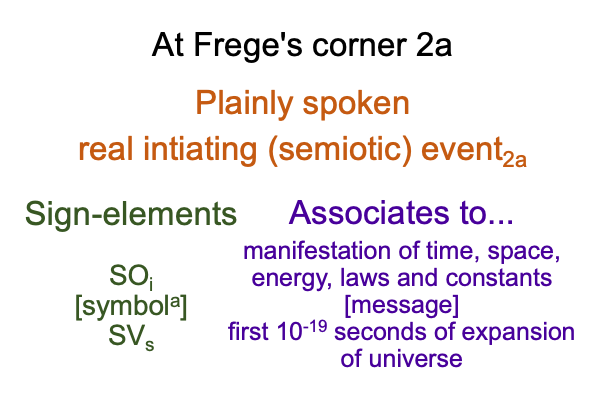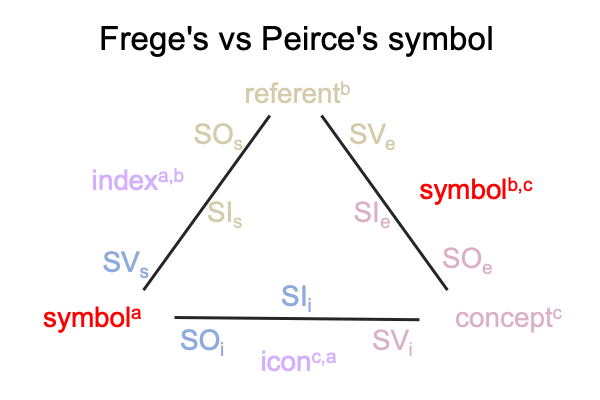1099 Wait a microsecond!
One-thousand nanoseconds?
Or ten-trillion 10-19 seconds?
1100 Let me look at section 6.3, titled “Potential Meanings During the Abiotic Period of the Evolution of the Universe”. The C1 spiralogenetic event is discussed a couple of pages into this section.
For the interventional sign-relation, the Big Bang2c (SVi) stands for the manifestation of space, time, energy, natural laws, the fundamental constants, and more2a (SOi) in regards to (a normal context similar to) what is happening3aoperating on the potential of ‘something’ happening1a (SIi).
1101 This is 13 billion years ago.
But, that is not the distinctive feature. The feature that differs from all other features, in the sense that it captures the attention of the reader (and author) is the time frame: 3.17 x 10-20 seconds. That is an outstanding feature. So, to me, it seems that this feature would be a good choice for SVs side of the real initiation (semiotic) event2a.
1102 Let me say that in a different manner.
The content-level thing2a is a real initiating (semiotic) event2a.
The actuality2a is a hylomorphe, somehow re-enacting Aristotle’s hylomorphe of matter [substance] form.
1103 The matter-like element is SOi, the manifestation of space, time, energy, natural laws, fundamental constants and so on.
The form-like element is SVs, the first 10-19 seconds of the expansion of the universe.
The substance-like [contiguity] is [symbola] for Frege and [message] for the category-based nested form for the definition of a spoken word.
1104 Here is a snapshot of different ways to depict the same corner.

1105 This raises a question about the word, “symbol”.
For Frege, a symbola is a corner of a semantic triangle. The other corners are referentb and conceptc. All three terms apply to the character of spoken words. Every speech act is a symbola, pointing to a referentb, and representing a conceptc.
Frege’s term, symbola, is not the same as Peirce’s use of the same term, symbolb,c, describing a sign-relation whose sign-object is based on habit, routine, convention, law as so on.
1106 The superscripts tell a story.
Frege’s symbola is a contiguity that belongs to the content-level of a three-level interscope.
Peirce’s symbolb,c is a sign-relation that entangles the situation and perspective levels.
1107 Here is a picture, in terms of Frege’s triangle.

1108 So I ask, “What is it about the spoken word that is captured by symbola that is not grasped by symbolb,c?”
Ferdinand de Saussure’s definition of spoken language provides a clue. Spoken language consists of two arbitrarily related systems of differences, parole and langue. I prefer to use the French, because an English translation of these words is misleading. Maybe, “speech” and “cogitation” will suffice. But, not for me.
1109 What does this imply?
Each parole (spoken word) differs from any other parole, constituting a system of differences. This system of differences must exist by convention, since there is no way for a symbolic order to exist on the qualities of similarity and pointing. So, the system of differences of symbolas touches base with symbolb,cs (sign-relations), because each symbola (spoken word) is different from any other symbola (spoken word). This allows the spoken word (symbola) to signify on the basis of habit, convention, law and so on (that is, what defines symbolb,c ).
1110 So, my selection of {SOi [symbola] SVs}2a is similar to a speaking person choosing just the right word (SVs) to label what is being manifested in the interventional sign-relation (SOi).
Yes, [symbola] is like choosing the right word (SVs) to image the message of the interventional sign-object (SOi).
Symbolb,c labels when information2b (SVe) stands for a goal2c (SOe) in regards to a normal context3c and potential1cthat are similar to what makes sense3c operating on the potential of ‘contextualizing the situation1c (SIe).
For other views on the word, “symbol”, see Comments on Robert Berwick and Noam Chomsky’s Book (2016) Why Only Us? (by Razie Mah, available at smashwords and other e-book venues).
